
Swell shark (Cephaloscyllium ventriosum). © PLOS ONE.
Biofluorescence is widespread among marine fish species, indicating its importance in communication and avoiding detection, finds a new study published in the journal PLOS ONE.
The research shows that biofluorescence — a phenomenon where organisms absorb light, transform it, and emit it as a different color — is more common in the animal kingdom than previously known. Conducting aquarium-based experiments and a series of reef dives using high-intensity blue lighting, the researchers led by scientists from the American Museum of Natural History identified more than 180 species of biofluorescent fishes across 50 fish families.
“By designing scientific lighting that mimics the ocean’s light along with cameras that can capture the animals’ fluorescent light, we can now catch a glimpse of this hidden biofluorescent universe,” said co-lead author David Gruber, an associate professor of biology at Baruch College and a research associate at the American Museum of Natural History (AMHN), in a statement. “Many shallow reef inhabitants and fish have the capabilities to detect fluorescent light and may be using biofluorescence in similar fashions to how animals use bioluminescence, such as to find mates and to camouflage.”
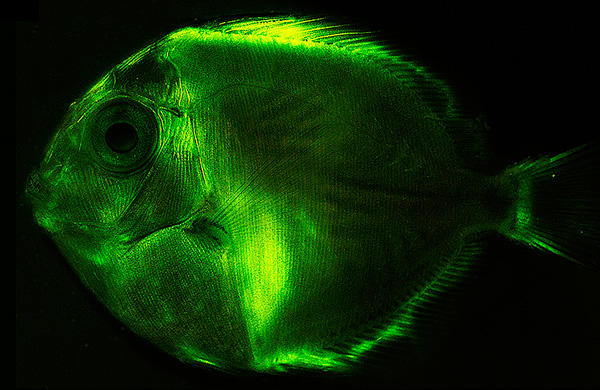
Glowing surgeonfish (Acanthurus coeruleus, larval). © PLOS ONE.

False moray eel (Kaupichthys brachychirus); I). Chlopsidae (Kaupichthys nuchalis); J). pipefish (Corythoichthys haematopterus).
Biofluorescence is useful to fish that live in a world where visible light is rapidly absorbed the deeper they live, seemingly leaving everything a hue of blue. But biofluorescent fish make the best of the conditions, absorbing blue light and re-emitting it in neon red, orange, and green patterns, opening up a world that is invisible to the human eye. The biofluorescence emitted by fish closely matches that emitted by other organisms that share their habitat, including corals.
“We’ve long known about biofluorescence underwater in organisms like corals, jellyfish, and even in land animals like butterflies and parrots, but fish biofluorescence has been reported in only a few research publications,” said co-lead author John Sparks, an ichthyologist at AMHN. “This paper is the first to look at the wide distribution of biofluorescence across fishes, and it opens up a number of new research areas.”
The biofluorescent proteins in fish could eventually be used for biomedical research and other applications, according to the authors.
Biofluorescent Fish Pictures

Images of reef fishes fluorescing in their natural habitat captured with a Red Epic video camera at night in the Solomon Islands. (A) A red fluorescing scorpionfish, Scorpaenopsis papuensis, perched on red fluorescing algae. (B) A green fluorescing nemipterid (bream), Scolopsis bilineata, near a green fluorescing Acropora sp. coralhead.
 Biofluorescent frogfish (Antennarius maculatus)
Biofluorescent frogfish (Antennarius maculatus)

Biofluorescent stonefish (Synanceia verrucosa)
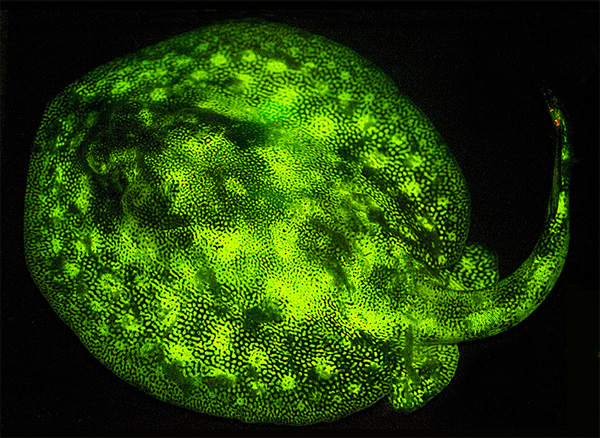
Biofluorescent ray (Urobatis jamaicensis)

A). swell shark (Cephaloscyllium ventriosum); B). ray (Urobatis jamaicensis); C). sole (Soleichthys heterorhinos); D). flathead (Cociella hutchinsi); E). lizardfish (Saurida gracilis); F). frogfish (Antennarius maculatus); G). stonefish (Synanceia verrucosa); H). false moray eel (Kaupichthys brachychirus); I). Chlopsidae (Kaupichthys nuchalis); J). pipefish (Corythoichthys haematopterus); K). sand stargazer (Gillellus uranidea); L). goby (Eviota sp.); M). Gobiidae (Eviota atriventris); N). surgeonfish (Acanthurus coeruleus, larval); O). threadfin bream (Scolopsis bilineata). © PLOS ONE
CITATION: Sparks JS, Schelly RC, Smith WL, Davis MP, Tchernov D, et al. (2014) The Covert World of Fish Biofluorescence: A Phylogenetically Widespread and Phenotypically Variable Phenomenon. PLoS ONE 9(1): e83259. doi:10.1371/journal.pone.0083259
Related articles
Biggest new animal discoveries of 2013 (photos)

(12/23/2013) Thousands of species were scientifically described for the first time in 2013. Many of these were ‘cryptic species’ that were identified after genetic analysis distinguished them from closely-related species, while others were totally novel. Below are some of the most interesting “new species” discoveries that took place or were formally announced in 2013.
Scientists discover a new coral in the French Polynesia

(12/20/2013) With humans scattered throughout the globe, it is hard to imagine lands still unexplored or species undocumented. Yet, on the remote French Polynesian Gambier Islands a new coral reef species has been found thriving in underwater lagoons. Echinophyllia tarae was discovered by marine biologist Francesca Benzoni and the research crew members of the Tara Oceans International Research Expedition.
Scientists make one of the biggest animal discoveries of the century: a new tapir

(12/16/2013) In what will likely be considered one of the biggest (literally) zoological discoveries of the Twenty-First Century, scientists today announced they have discovered a new species of tapir in Brazil and Colombia. The new mammal, hidden from science but known to local indigenous tribes, is actually one of the biggest animals on the continent, although it’s still the smallest living tapir. Described in the Journal of Mammology, the scientists have named the new tapir Tapirus kabomani after the name for “tapir” in the local Paumari language: “Arabo kabomani.”
Animal Earth: exploring the hidden biodiversity of our planet
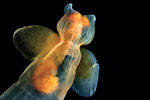
(12/03/2013) Most of the species on Earth we never see. In fact, we have no idea what they look like, much less how spectacular they are. In general, people can identify relatively few of their backyard species, much less those of other continents. This disconnect likely leads to an inability in the general public to relate to biodiversity and, by extension, the loss of it. One of the most remarkable books I have read is a recent release that makes serious strides to repair that disconnect and affirm the human bond with biodiversity. Animal Earth: The Amazing Diversity of Living Creatures written by Ross Piper, a zoologist with the University of Leeds, opens up the door to discovery.
Scientists discover new cat species roaming Brazil
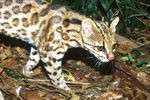
(11/27/2013) As a family, cats are some of the most well-studied animals on Earth, but that doesn’t mean these adept carnivores don’t continue to surprise us. Scientists have announced today the stunning discovery of a new species of cat, long-confused with another. Looking at the molecular data of small cats in Brazil, researchers found that the tigrina—also known as the oncilla in Central America—is actually two separate species. The new species has been dubbed Leopardus guttulus and is found in the Atlantic Forest of southern Brazil, while the other Leopardus tigrinus is found in the cerrado and Caatinga ecosystems in northeastern Brazil.
Asia’s ‘unicorn’ photographed in Vietnam
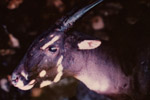
(11/12/2013) In 1992, scientists made a spectacular discovery: a large, land mammal (200 pounds) that had somehow eluded science even as humans visited the moon and split the atom. Its discoverers, with WWF and Vietnam’s Ministry of Forestry, dubbed the species the saola (Pseudoryx nghetinhensis). Found in the Annamite Mountains in Laos and Vietnam, the saola is a two-horned beautiful bovine that resembles an African antelope and, given its rarity, has been called the Asian unicorn. Since its discovery, scientists have managed to take photos via camera trap of a wild saola (in 1999) and even briefly studied live specimens brought into villages in Laos before they died (in 1996 and again in 2010), however the constant fear of extinction loomed over efforts to save the species. But WWF has announced good news today: a camera trap has taken photos of a saola in an unnamed protected area in Vietnam, the first documentation of the animal in the country in 15 years.